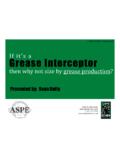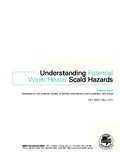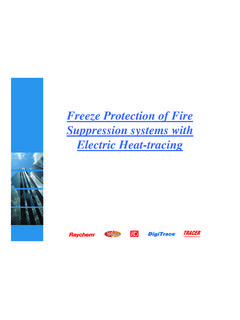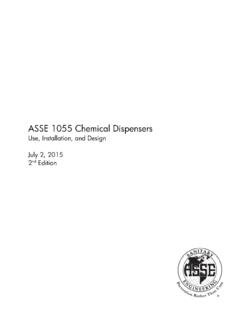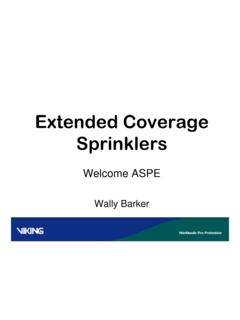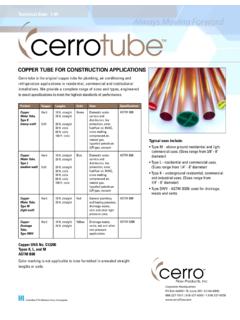Transcription of Adjustmentof Automatic Compensating Valves Prevent ...
1 adjustment of Automatic Compensating Valves to Prevent Potential Scald HazardsA White Paper Developed by the ASSE International Scald Awareness Task Group Prevention Rather Than CureASSE International 18927 Hickory Creek Drive, Suite 220, Mokena, Illinois 60448 Phone: (708) 995-3019 | http: of Automatic Compensating Valves to Prevent Potential Scald HazardsSection 1 Section 2 Section 3 Section 4 Section 5 Section 62345678 ContentsExecutive SummaryPurposeThe ProblemSolutions to the ProblemDefinitionsTask Group MembersContentsTable of3 adjustment of Automatic Compensating Valves to Prevent Potential Scald HazardsThe ASSE International Scald Awareness Task Group was formed to educate and give guidance to the general public and the plumbing industry on potential scalding hazards associated with domestic hot water at the point of use.
2 Scald burns from hot bath or shower water temperatures can happen to anyone at any time; however, young children, older adults and people with disabilities are more susceptible to injuries from hot water. The severity of scald injuries is dependent on the temperature of the hot water and the length of injuries caused by hot water at the tap are almost completely plumbing codes, for many years now, have required the installation of Automatic Compensating -type shower or tub/shower combination Valves in both new and replacement applications. This type of valve has a temperature-limiting feature that controls the maximum temperature of the bath or shower water at the point of use. The temperature-limiting feature, the limit stop, must be set to the desired temperature by the installer. Every manufacturer includes detailed instructions with their products for the setting of the limit many instances the installer does not take time to read and follow the manufacturer s installation instructions, or is otherwise not aware that the device includes a temperature limit stop that requires setting.
3 Also, in many installations, hot water may not be available at the time of completing the installation of the valve; in this case, it is the responsibility of the installer to return when hot water is available to set the limit stop. From the installer to the homeowner to the handyman to the end user, this white paper is intended to make everyone aware that the limit stop must be set to maintain a safe water temperature for bathing purposes. The maximum safe water temperature, usually 120 degrees Fahrenheit, is mandated by the local code, but the limit stop may be set to a lower temperature at the preference of the homeowner or end the primary focus of this paper is with shower and tub/shower combination type Valves that meet ASSE 1016-2011/ASME , Performance Requirements for Automatic Compensating Valves for Individual Showers and Tub/Shower Combinations, there are two other types of devices, described in Section 2, that also have limit stop features that must be set at the time of installation.
4 Note:ASSE ASSE InternationalASME American Society of Mechanical EngineersCSA Canadian Standards AssociationExecutive SummarySection 14 adjustment of Automatic Compensating Valves to Prevent Potential Scald HazardsThe ASSE International Scald Awareness Task Group was formed to provide cautionary information on the many ways that people can be exposed to the potentially scalding hazards of domestic hot water at the point of primary purpose of this paper is to educate (or possibly the better word is re-educate ) the general public and the plumbing industry on the necessity of properly setting limit stops on water temperature control devices. This paper does not attempt to determine which device should be used in which application, nor does it attempt to determine if one type, style, or manufacturer is better than another.
5 adjustment of Automatic Compensating Valves to Prevent Potential Scald Hazards defines what limit stops do and explains why they must be properly set. Since limit stop adjustments may be different depending on the manufacturer of the device, the paper does not describe how to adjust the limit stops, but it does tell readers where they can find that information. The ASSE Scald Awareness Task Group s primary concern is with shower and tub/shower combination Valves . However, other end point applications, such as for Roman tubs (whirlpool tubs), sitz baths, or gang showers, also require the installation of a device with a limit stop feature to control the maximum water temperature. Limit stops on these other end point applications must also be set at the time of are three main Valves (devices) that automatically control water outlet temperatures at plumbing fixtures once the valve is properly installed and the limit stop is properly set.
6 These three Valves (devices) are:1. Shower and tub/shower Automatic Compensating mixing Valves conforming to ASSE 1016-2011/ASME , Performance Requirements for Automatic Compensating Valves for Individual Showers and Tub/Shower Combinations. There are three types of shower and tub/shower Automatic Compensating mixing Valves : Type P Pressure-Balancing Compensating Valve Type T Thermostatic Compensating Valve Type T/P Combination Pressure-Balancing and Thermostatic Compensating Valve Note: Not all shower Valves have a maximum temperature limit adjustment . Older Valves may also be non- Compensating types, such as a two-handle shower or tub/shower valve. Check to see if the valve(s) in your installation has a Compensating feature or a limit stop; examining the manufacturer s installation literature can accomplish this.
7 If literature is not available, try searching online using the manufacturer s model number. If you still cannot find the literature, consult with a licensed master plumber or a plumbing engineer who is certified in plumbing design (CPD) to see if the fixture has a Compensating feature or limit stop, and for instructions on how to adjust the maximum limit stop to Prevent scalding. 2. Automatic temperature control mixing Valves conforming to ASSE 1069-2005, Performance Requirements for Automatic Temperature Control Mixing Valves . Typical application is for devices that service end use fittings, including, but not limited to, multiple shower units (gang) or sitz Temperature limiting devices conforming to ASSE 1070-2004, Performance Requirements for Water Temperature Limiting Devices, or CSA , plumbing Products and Materials.
8 Typical application is to supply and maintain tempered water to sinks and 25 adjustment of Automatic Compensating Valves to Prevent Potential Scald HazardsThere may be a multitude of conditions that create the problem of not having properly set limit stops on temperature limiting devices. Some of the most common:1. Installation errors by the installer, whether that installer is a do-it-yourself homeowner or a plumber. Even though every manufacturer includes instructions with every valve on how to properly set the limit stops of their devices, it seems that, for a multitude of reasons, limit stops are not being properly set. 2. Hot water may not be available at the time of device installation. This is true on many commercial/institutional installations. However, this is not an excuse for the installer to not return to set the limit stops when the hot water is Often these Valves are installed before water is available, which leads to limit stops not being adjusted.
9 This leads to inadequate or incomplete final testing upon the valve s The homeowner or installer may not be aware that any change in the supply hot water temperature may necessitate a change to the setting of the limit stops. 5. Normal regional/seasonal water temperature variations may necessitate the resetting of the limit stop. 6. The end users may not be aware of the importance of temperature limit stops and how to maintain a proper Some current installations may not have temperature limiting devices to control the final water temperature at the point of ProblemSection 36 adjustment of Automatic Compensating Valves to Prevent Potential Scald Hazards1. The main purpose of this paper is to re-educate the plumbing industry and educate the do-it-yourselfer on the necessity and reasons for properly setting the limit stop on a If hot water is not available at time of final inspection, the plumbing contractor should leave their contact information and instructions for the end user.
10 The plumbing inspector should also note on the final inspection report that the hot water was not available at time of inspection and the limit stops have not been set or Once the valve has been completely installed and hot water is available, the valve must be tested at, or below, the temperature setting allowed by the plumbing code. This is not only true for new installations, but also for retrofit Any significant change in the incoming water temperature, either cold or hot, may require the limit stop to be reset. The ultimate solution is to check the outlet temperature of the valve (using a thermometer) when the temperature setting of the water heater or thermostatic mixing valve is adjusted, or when the water heater is replaced. In some climates, the incoming cold water temperature can change significantly from winter to summer and summer to winter.
